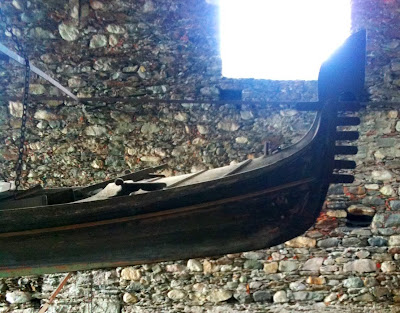 William Rich, who used to live in Venice, recently found this incredible vessel hanging in a boat storage facility not far from his current home in Lugano, Switzerland. One of the things that makes this boat even more unique is that she was built locally, in the very lake region she resides in now. She was gifted to the Borromea family and is currently stored at the palazzo on Isola Madre on Lago Maggiore. The lake occupies part of the border between southern Switzerland and the Piedmont region of north-west Italy. Isola Madre is Italian soil.
William Rich, who used to live in Venice, recently found this incredible vessel hanging in a boat storage facility not far from his current home in Lugano, Switzerland. One of the things that makes this boat even more unique is that she was built locally, in the very lake region she resides in now. She was gifted to the Borromea family and is currently stored at the palazzo on Isola Madre on Lago Maggiore. The lake occupies part of the border between southern Switzerland and the Piedmont region of north-west Italy. Isola Madre is Italian soil.She's believed to be two centuries old, has the original felze (cabin), along with the forcole and remi which were hand-carved for her so long ago.
 Some details here are truly "gondola", while others raise questions.
Some details here are truly "gondola", while others raise questions.
William writes:
"I chatted with a museum guy about it. He confirmed that it does not float and is thus hung in this boat yard that you see in pix. I couldn't get a good shot at it because access was through a small opening and from a larger opening the angle was wrong.
He said the accessories were all original.
Couldn't see well enough to determine if asymetric. He said it was built locally at the end of the 1700s and gifted to the family ."
Taking a closer look at the forcole on this boat, I can't help but think that in a way we are viewing a "time capsule". Every part of the boat has been kept the same, according to the way things were two hundred years ago.
The forcola da prova looks a lot like one in the painting Salvataggio Miracoloso by Girolamo Forabosco.
 The morso on this forcola has a noticeable upward angle.
The morso on this forcola has a noticeable upward angle.Meanwhile, the forcola da poppa has little or no "elbow" - taking a more plank-like shape. I've seen similar forcole in paintings by Carpaccio, Bellini, and Tintoretto.

The decks of the boat are reminiscent of some variations only seen in paintings and old photographs. One can only imagine how this amazing boat must have looked and rowed when she was first launched - possible two hundred years ago.

My thanks go out to William for providing the photos and information on this historic vessel.
To read about another vessel he had some association with, check out my post from April of this year entitled "William".
3 comments:
Tremontin didn't add the asymmetry till the mid 1800's.
> Tremontin didn't add the asymmetry till the mid 1800's.
Probably like 1880's? Essentially when the city went bankrupt shortly after the italian reunification, venetians could no longer afford to keep TWO house gondoliers per boat.
Furthermore, there wasn't any reason to hurry in the economically hybernated city, so a single oarsman was enough for walking pace speeds, even if the single-oar principle required new design, bended gondola hulls.
After the solo gondolier change occured, suddenly there were so many seldom employed gondoliers in Venice, who stood by the canalside, waiting for a patron all day, hoping to earn some money to feed the family.
Some months ago I found an e-copy of a 120-year old N.Y. Times article about that era, it was a sad reading.
BTW: I have some doubts if a well-preserved wooden object can last 200+ years in close vicinity of water.
Maybe if it was fully submerged in cold and anoxygenic water, but not in plan air with just a roof for protection? Shouldn't humidity destroy it?
Probably just ask Gilberto Penzo about the Lago Maggiore royal "gondola"? He surely has some info about that.
I don't think she's an authentic gondola but a well done copy. Nereo
Post a Comment